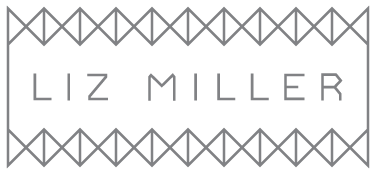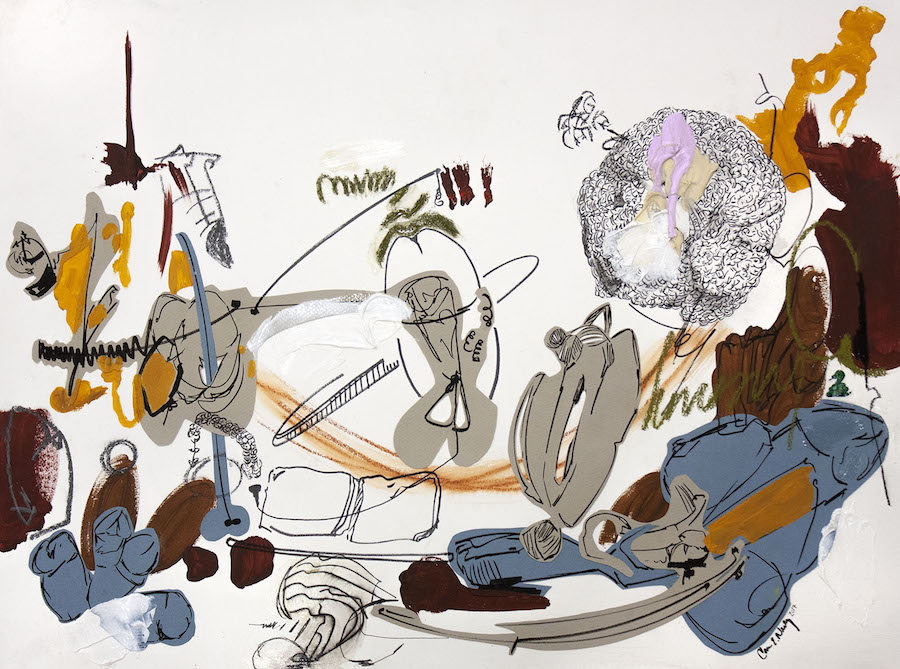"Each material translation involves a different type of engagement with the gestures, and a new level of intimacy with each step": An Interview With Carmen Neely
In 2017, I read about the work of Carmen Neely in Art in America. I was excited about the pronounced materiality of her paintings and impressed with her ability to combine sensuous mark-making with interludes that feel raw, aggressive, and ominous. Of course, these initial impressions were based on photographic images. My admiration only deepened when I visited Neely’s studio in Charlotte, North Carolina this fall. She took time away from an exciting schedule of forthcoming exhibitions to tell me more about her work. Here’s our conversation:
Carmen Neely, In an alternate reality, flower crown, oil on canvas, 80 x 76.5 in, 2018. Photo courtesy of the artist
Liz Miller: While it’s easy to think of abstract painting as action-based, you call attention to the presence of the gesture as a noun. Through the replication of painterly gestures in materials such as Plexiglas and polymer clay, and through the insertion of found-objects, the gesture becomes not just an action, but also an object and an artifact. In your artist statement you speak about the importance of objects and collections in regards to relationships and family history. At what point did you realize that you wanted to translate these ideas through painting? Why is painting a powerful vehicle for this conversation?
Carmen Neely: Painting is a powerful medium for these conversations because conceptions of embodiment are always present in the medium. Collections are so much about personal projections. In many regards, that unique relationship we create between ourselves and our chosen objects in the world mimics the relationship a painter has with their marks. It is also echoed in the experience a viewer has witnessing those marks. Each level of engagement involves some combination of a person projecting their own desires, fears, expectations, memories, opinions, etc. onto this visual language and some universal comprehension of symbology.
Just like with my paternal grandmother’s collection of salt and pepper shakers - they are all very specific forms. A lot of them are kitschy and gimmicky*. There are Siamese cats, chickens, barrels, Disney characters… all representative of a type of commercialized Americana. But then they also speak of particular eras based on these aesthetics, and I can guess which stages of her life they may have emerged from. More importantly, they carry a personal link to her living room shelves. These shakers are familiar friends I remember being present for many Christmases and birthdays. Each pair was deliberately selected to fit into a series that only she understood. Therefore, their entirety represents some aspect of her essence, and it is significant that I keep her with me by setting them up in groups around my house.
_____________________
*It should also be known that many of her shakers are really funky and interesting too! Some of my favorites are a pair of feet with painted toenails (the seasonings sprinkle out of the ankles) and lamp posts that hold the seasonings in their lanterns.
Some of Neely’s grandmother's salt shakers on a living room shelf, 2018. Photo courtesy of the artist
Above: Carmen Neely, Keep it 100, vinyl, pillow, polymer clay, safety pins, silicone, glue, staples, paper, duct tape, ear plugs, red wine, felt, beads, model magic, yarn, fiberfill, wood, cardboard, acrylic, oil on canvas, 84 x 72 in, 2016. Below: Carmen Neely, Keep it 100 (detail). Photos courtesy of the artist
Liz Miller: One of the joys and challenges of abstraction is the ambiguity it affords both the artist and the audience. How do you navigate the space between the implied and the literal in your work?
Carmen Neely: Having a specific intention while painting is a necessity for me. I believe that the resulting gestures carry a particular energy with them in the same way that my grandmother’s salt shakers carry her energy, or my great grandmother’s hat makes me feel close to her when I wear it. Cy Twombly spoke about the distinction between his gestures “illustrating” an event or an action versus them “experiencing” or “embodying” what is meant to be communicated. I think of my gestures in the same way, though I recognize that this does leave much of a gray area for interpretation. For people who are interested in truly having a dialogue with paintings when they stand before them, I know that this kind of embodiment must communicate something. For example, I don’t always know the full narrative at play in Twombly’s work when I’m fortunate enough to view a piece in person. Regardless, I am always moved. Those gestures, and the histories embedded in his paintings are visceral. It always reads as honest, and vulnerability is present in each scratch, stroke, and scribble. My hope is that by approaching each of my own paintings with this type of honest investment in each abstract gesture, that some genuine energy can be shared and read in the work.
Carmen Neely, Hard to believe you can eat biscuits at a time like this, collage, ink and acrylic on paper, 18 x 24 in, 2018. Photo courtesy of the artist
Liz Miller: When I think of collections, I think of the individual objects, but also how individual elements of a collection gain significance and context through the objects around them. In the same way, the disparate marks that comprise your paintings seem to be different dialects of the same language—they clash in turbulent and unexpected ways, but ultimately coalesce to form a coherent visual system. The actions in your paintings seem quick, but I sense a longer history in the way these marks accrue. Tell me a bit about the velocity of these works—are they actually made quickly?
Carmen Neely: I think I experience “bursts” of painting energy. So yes, I tend to make many decisions in a short time span, but this occurs across multiple sessions. The most important element for me that absolutely must be present when I approach the canvas is a vivid recollection of the narrative I’m intending to transcribe. Sometimes if I wait too long to get the image going, or I take too long of a break between painting sessions the narrative just can’t stick. I’ll have to stop and move on to something else, or the narrative morphs into another memory out of necessity. I’m clinging to specifics when I work, and without something to cling to, I lose clarity.
The idea of a visual system existing in my work comes from this internal process, but is also related to the ways in which I honor gestures beyond their initial realization in paint. I consider them to exist as multiple generations of the same mark. I do also consider what kind of lives they may lead in each new format, and their potential to be part of new stories. Each material translation involves a different type of engagement with the gestures, and a new level of intimacy with each step.
Above: Carmen Neely, It is love, but even so, oil on canvas, 80.5 x 77 in, 2018. Below: Carmen Neely, Don't just hope it!, polymer clay, resin, plexiglass, silicone, vinyl, graphite, duct tape, acrylic on panel, 48 x 48 in, 2017. Photos courtesy of the artist
Liz Miller: Your works exemplify beauty and violence—and I can’t separate the two. They are gorgeously tumultuous and beautifully tortured, and aggressive mark-making is often carried out in bursts of buoyant pastel pink, peach, or lavender. What is the role of beauty in your work, and why is beauty in art relevant now? Or is it?
Carmen Neely: I don’t necessarily create images with an intent to exemplify beauty. My focus is always on translating a truth. Because my major source of inspiration stems from intimate relationships that are by nature complex blends of pleasure and pain, that dichotomy extends to gestural behaviors. I am also a black woman in the midst of a climate that is often hostile towards my body and which aims to project fear onto my existence. Thus I see it as a radical act to respond by dealing with content about my own softness, joy, love, sex and vulnerability.
I’m currently finishing up two bodies of work in preparation for a solo booth at UNTITLED Miami, and solo exhibition in Dusseldorf, DE. The Miami show is entirely about my most recent romantic relationship, entitled Intellectualized Intimacy. So these intersections of aggressive acts and soft caresses in paint have felt crucial to embodying the nature of a tortured love. It was a kind of intimacy that involved a sincere sweetness alongside recurrent injury. After delving into this work and reliving so many of our shared moments, it occurred to me that the series was really about love and anxiety.
Carmen Neely, Remember your Power, collage, ink, sticker and acrylic on paper, 18 x 24 in, 2017. Photo courtesy of the artist
Liz Miller: What are you working on now, and where can we see your work in the future?
Carmen Neely: Intellectualized Intimacy will be on view through Jane Lombard Gallery, NY at UNTITLED Art Fair this December. We will be in Booth D14, December 5-9.
My solo exhibition, Lifelines, will be on view at Setareh Gallery in Dusseldorf, DE. Full show dates TBA, but the opening is January 11th!
You can also opt to receive newsletter updates about future projects via my website! `
Carmen Neely, Simon and Debbie Throwback: One, lithograph, graphite, watercolor, canvas, instant photo, felt on paper, 13.5 x 20 in, 2017. Photo courtesy of the artist
Carmen Neely (b. 1987, Charlotte, NC) earned a MFA in studio art from The University of North Carolina at Greensboro in 2016, and a BFA in painting from The University of North Carolina at Charlotte in 2012. Recent exhibitions include; it makes it more so if you say so, Jane Lombard Gallery, Chelsea NY; 17 feet away, Lump Gallery, Raleigh, NC; Behaving Differently, Plank Gallery, Seattle WA, Black Blooded: Curated by Jessica Gaynelle Moss, The New Gallery, Charlotte NC. Her work has been featured in both ARTFORUM and Art in America Magazine. Neely has been a resident artist at Sparkbox Studio, Ontario, Canada, and Vermont Studio Center. Forthcoming shows include; Intellectualized Intimacy, a solo booth at UNTITLED Art Fair, Miami, December 2018 and Neely's first solo international exhibition, Lifelines, Setareh Gallery, Dusseldorf, DE, in January 2019. Neely currently lives in Charlotte NC.









